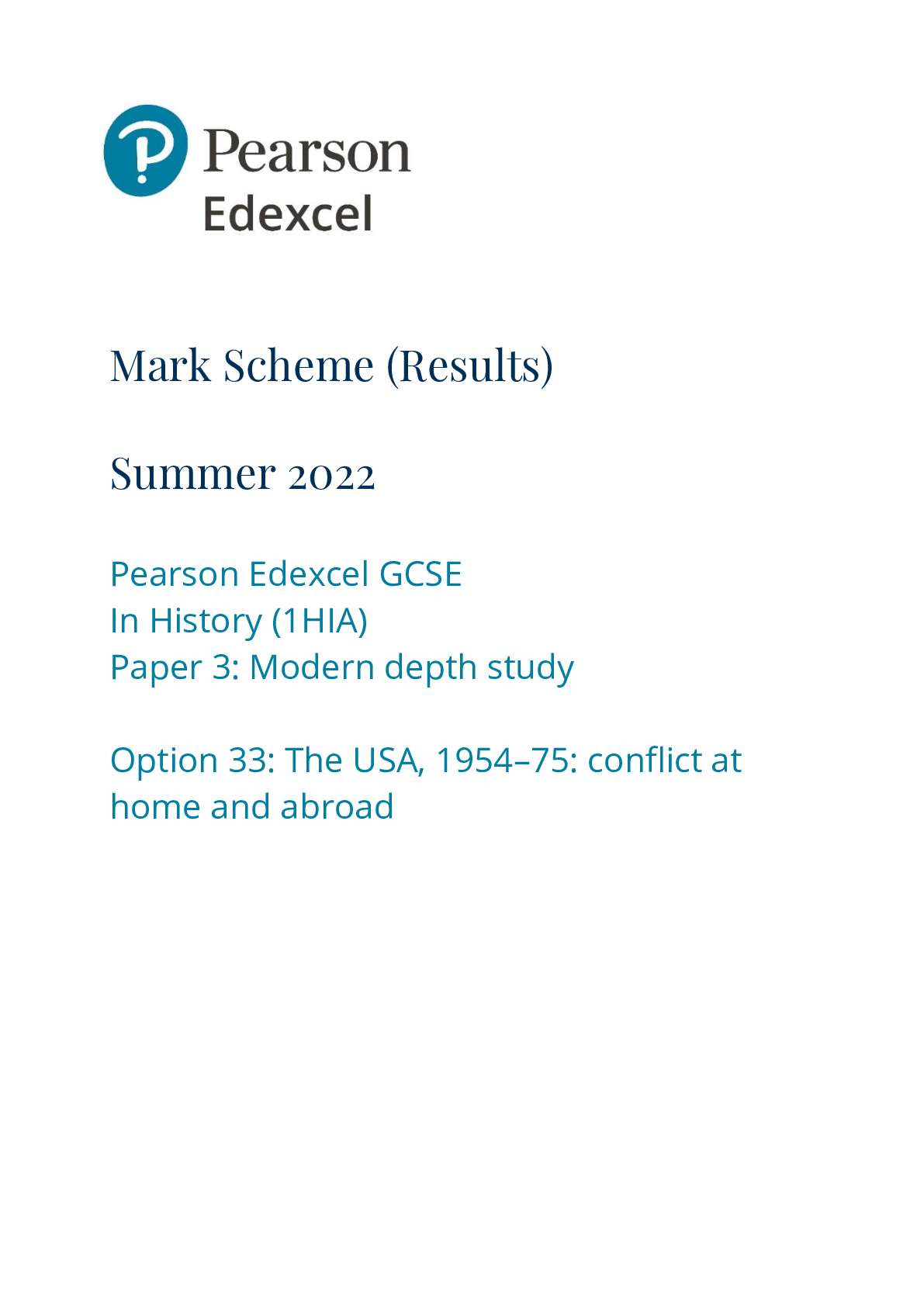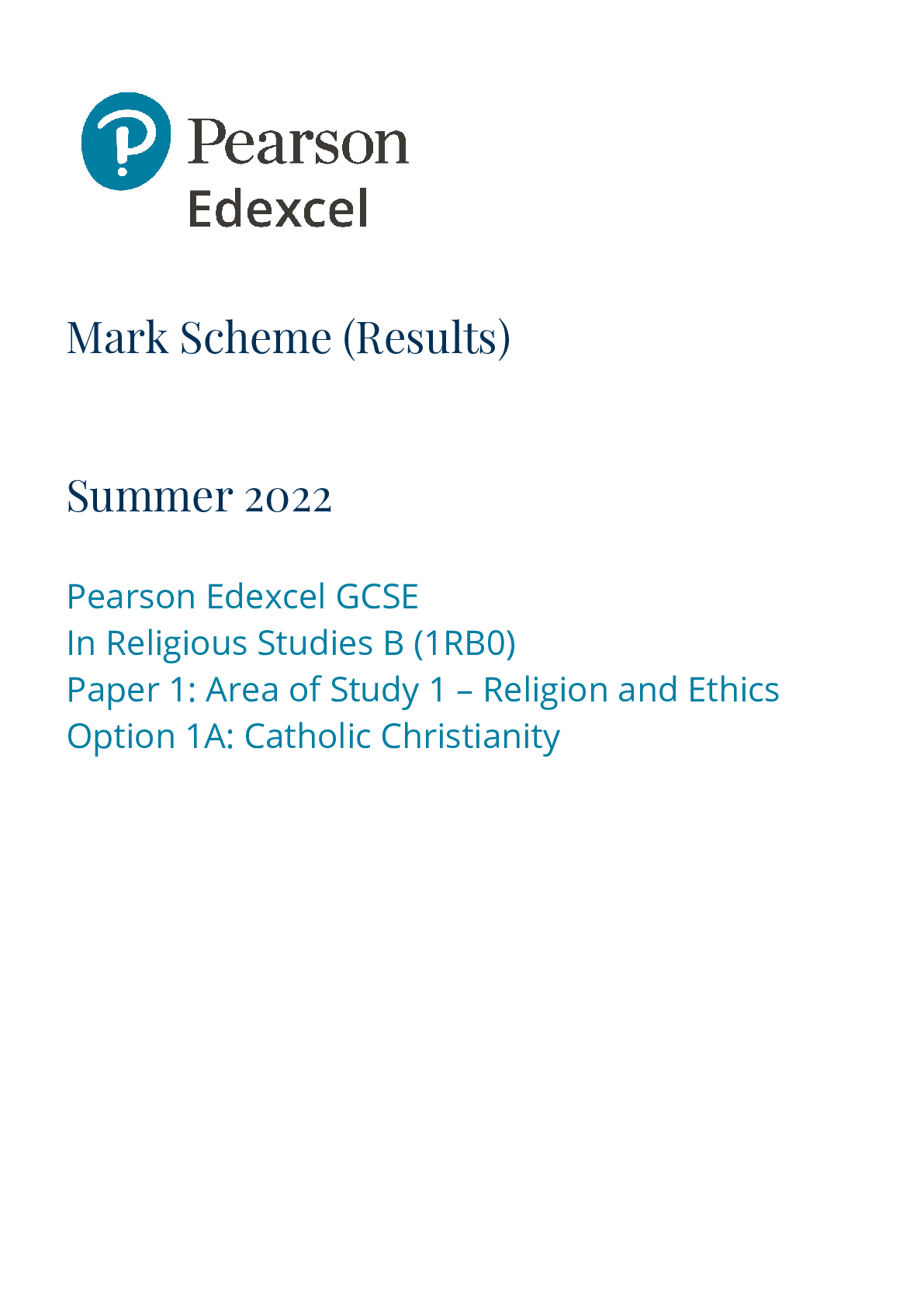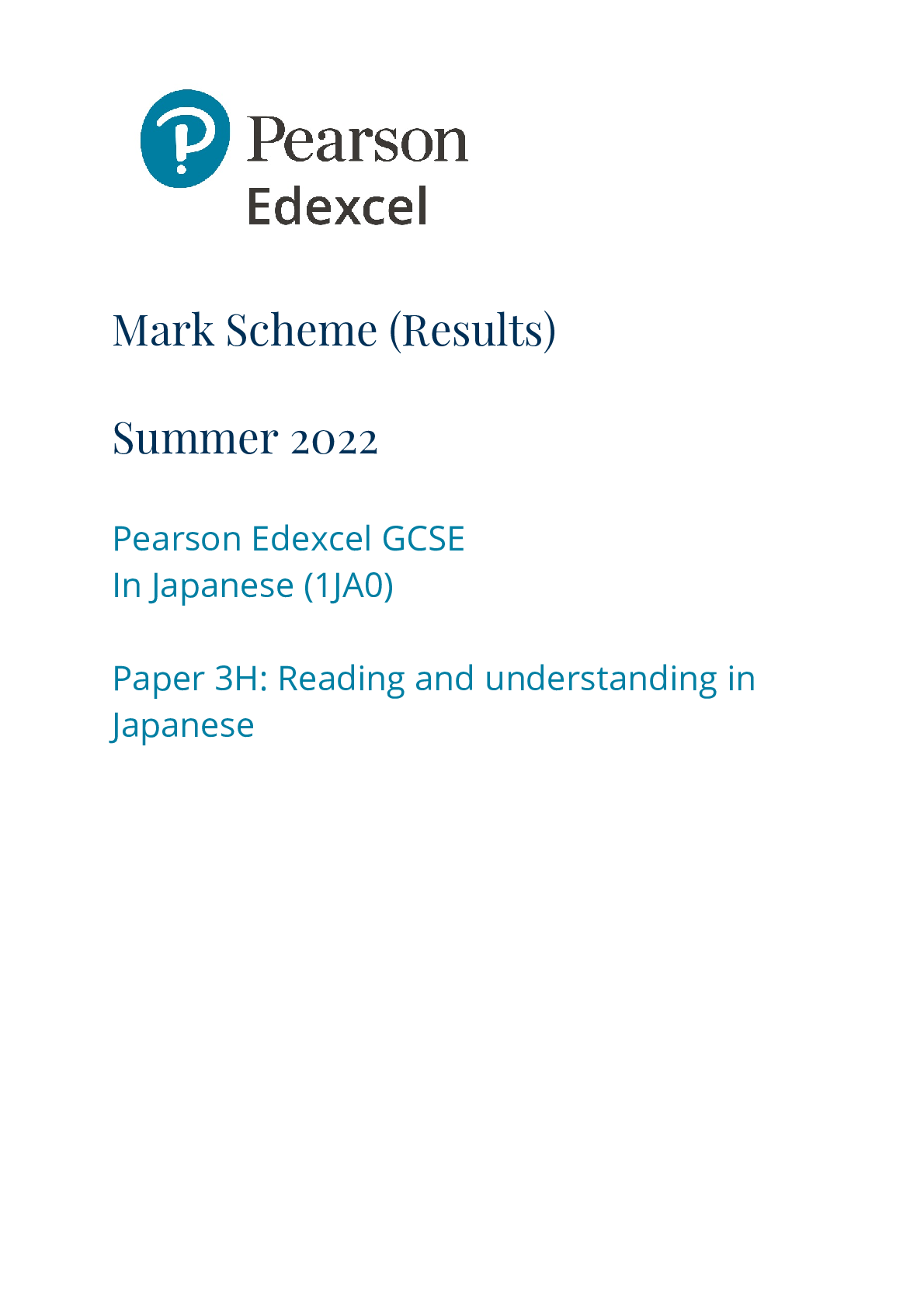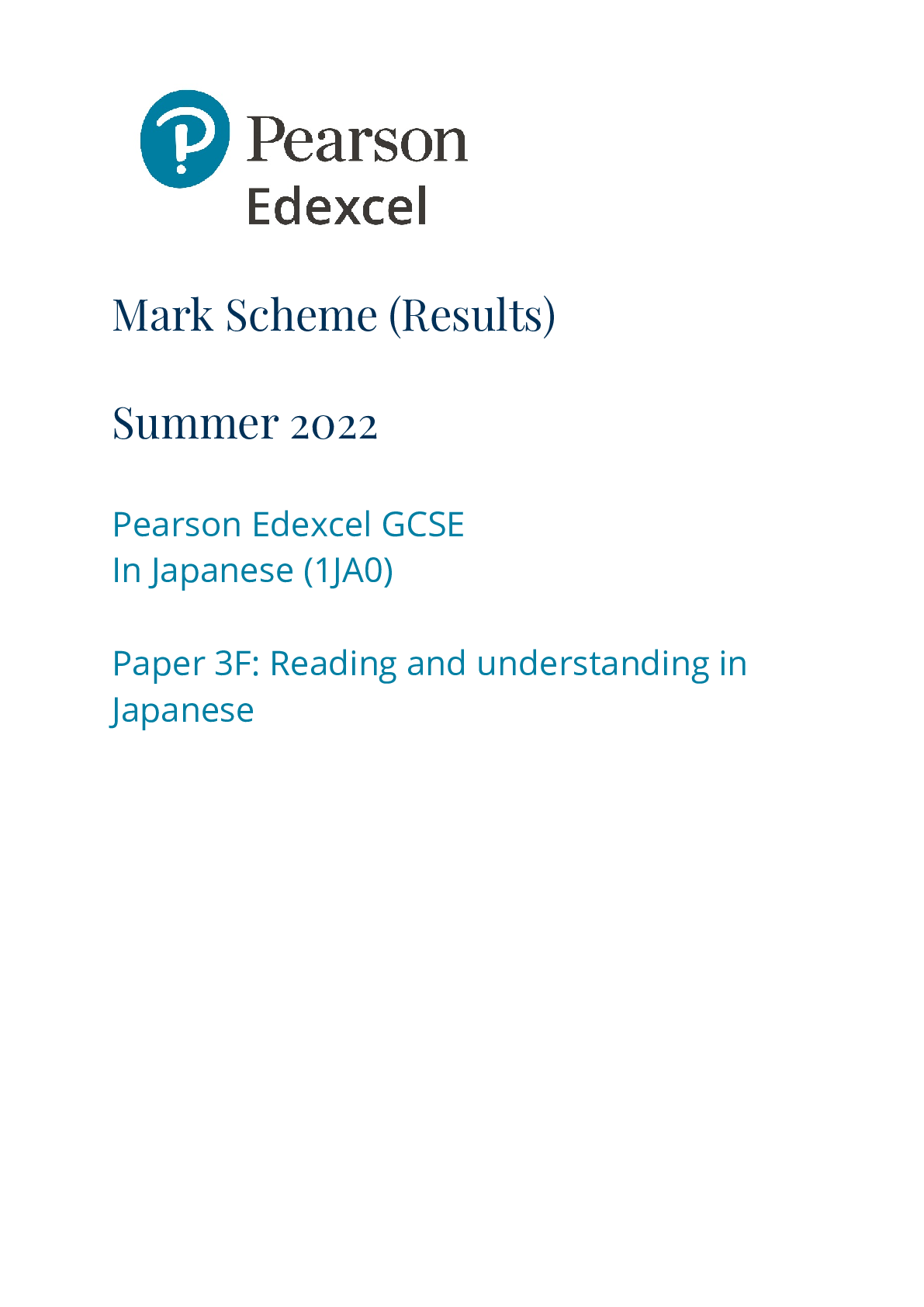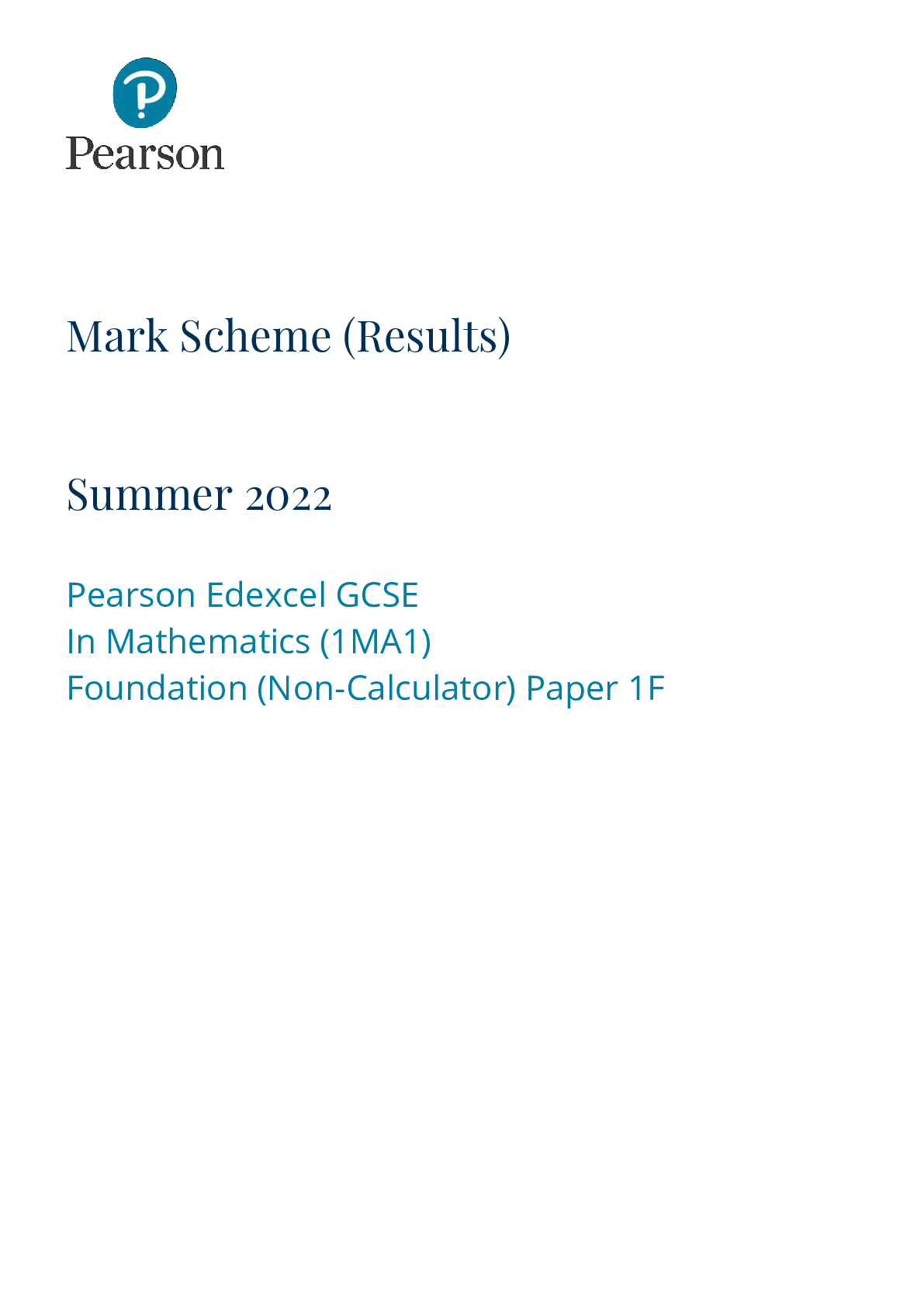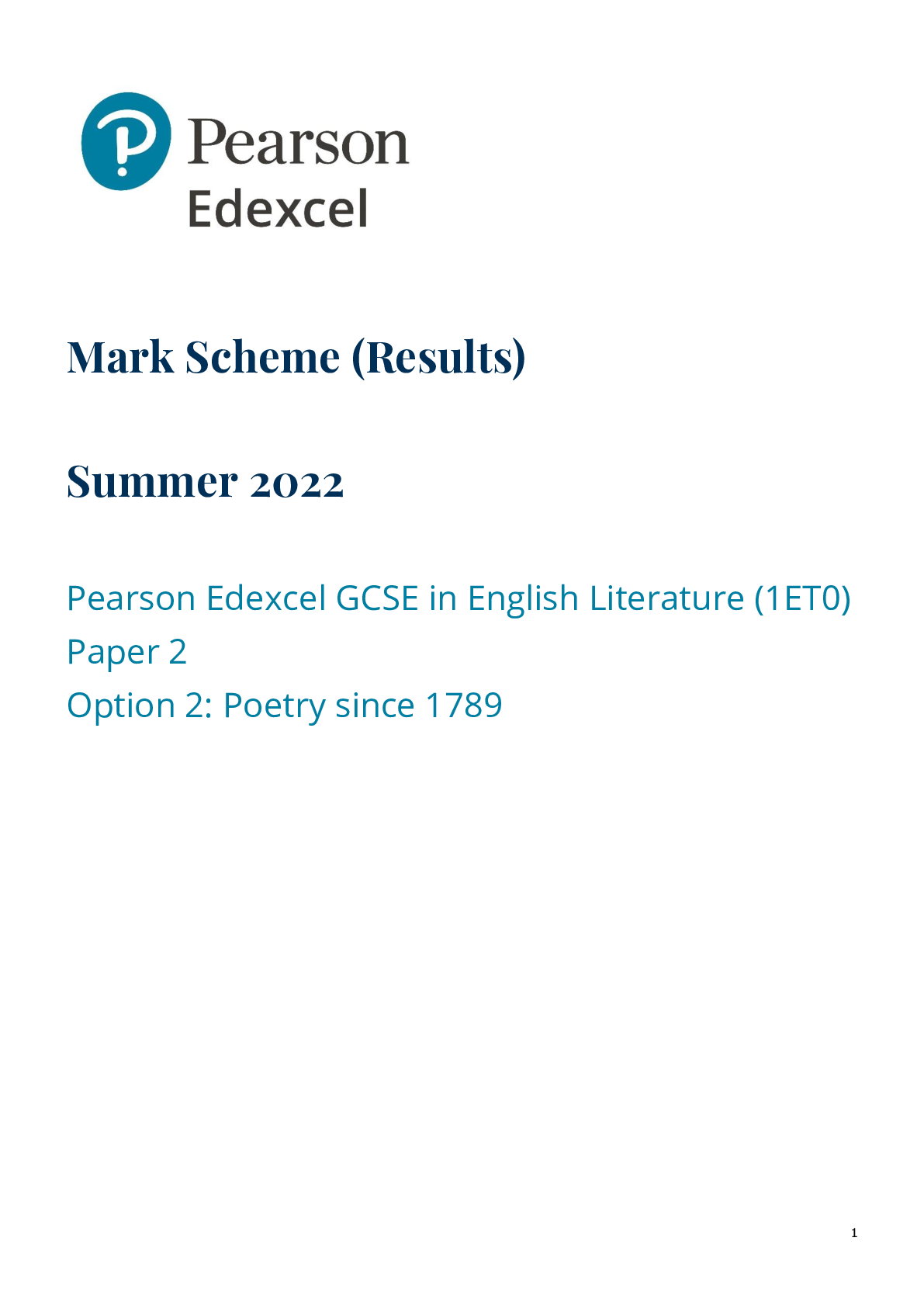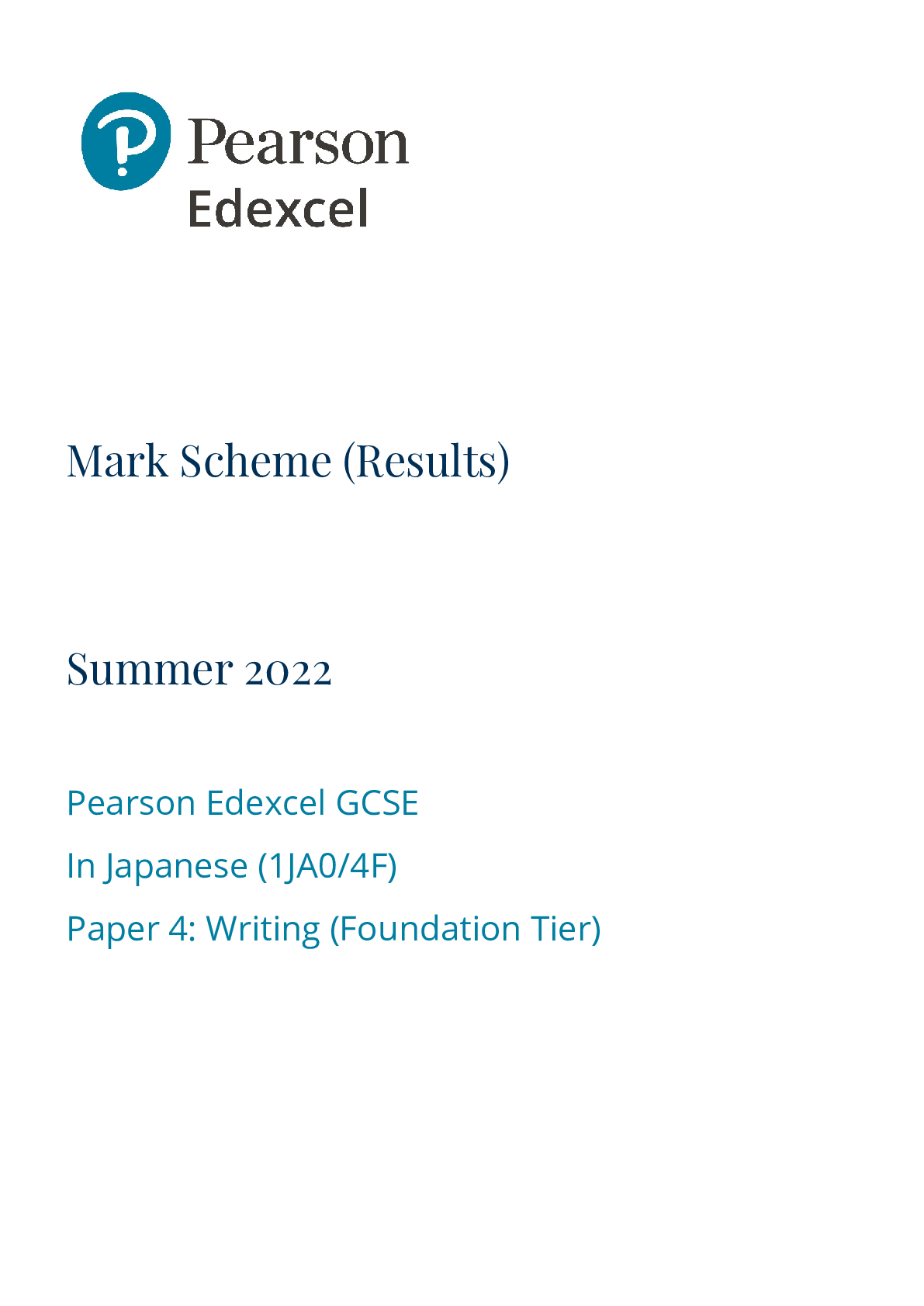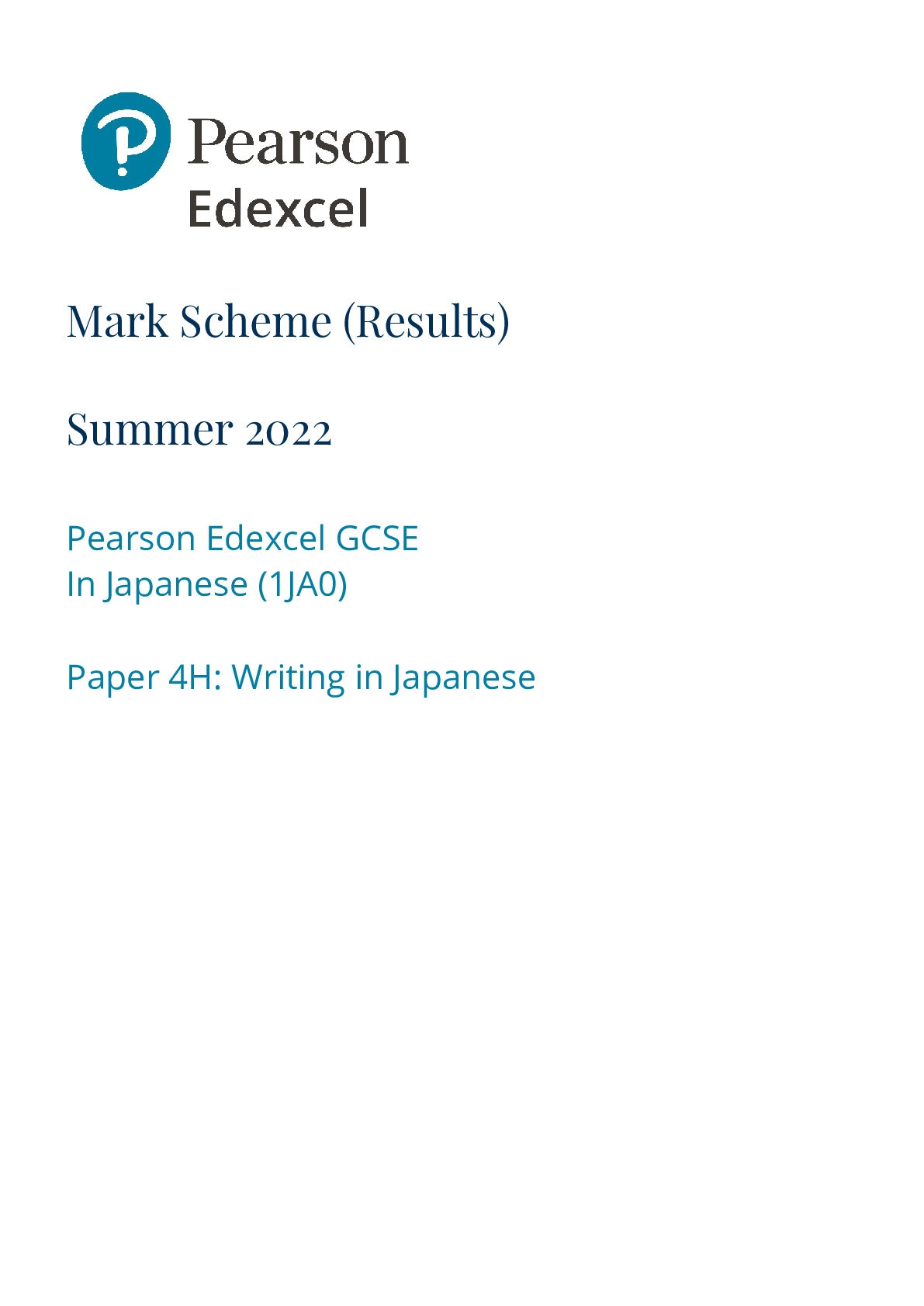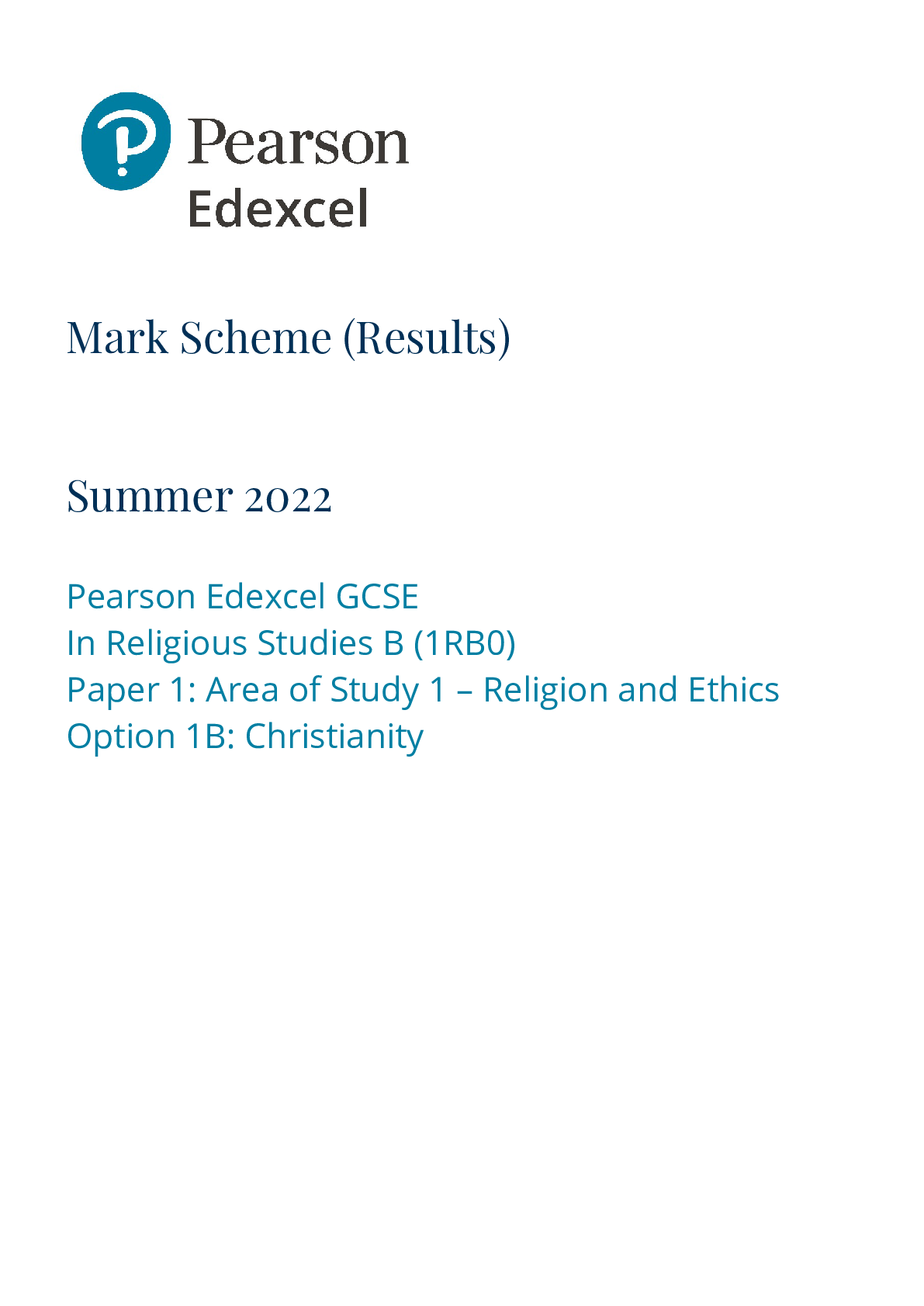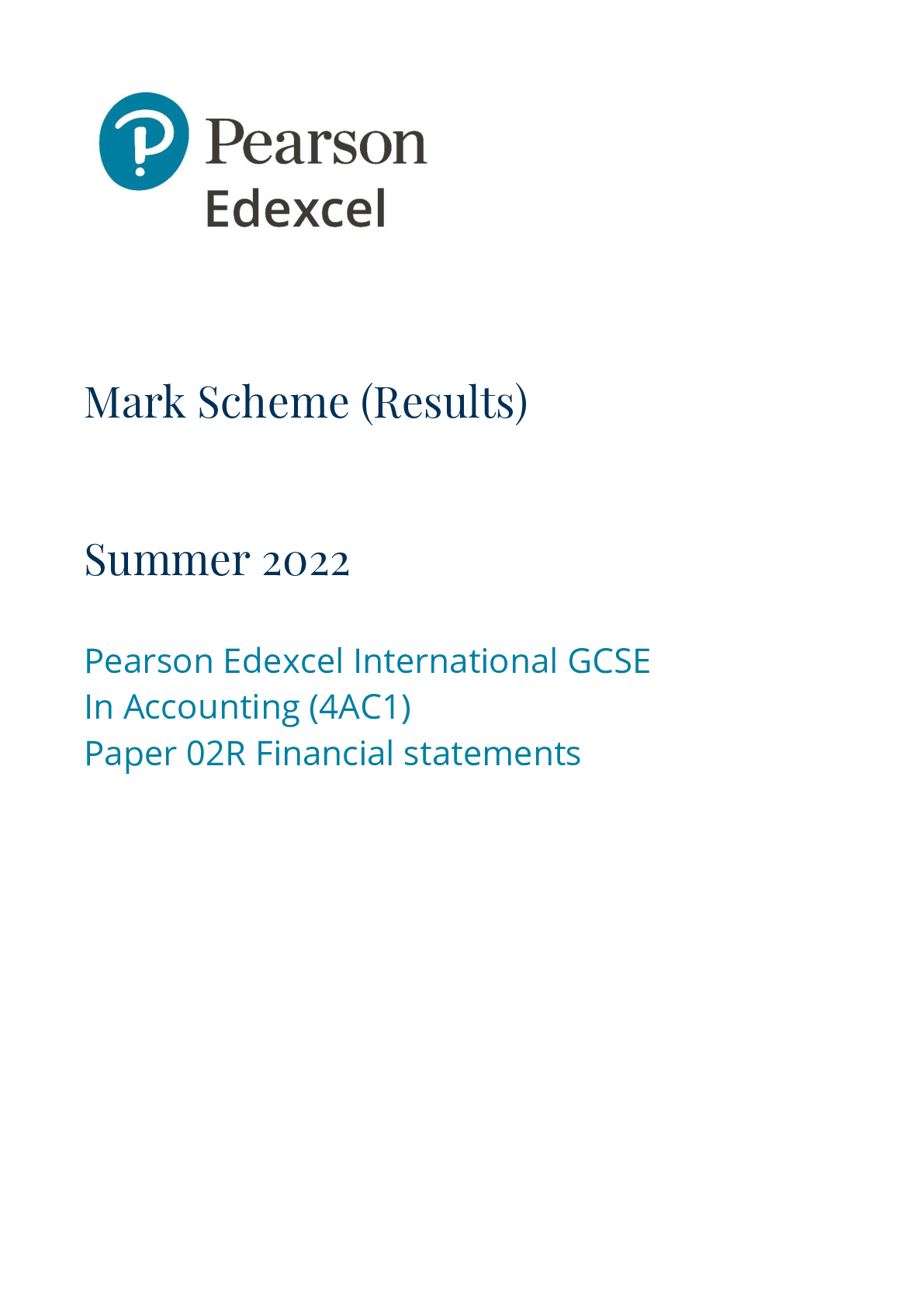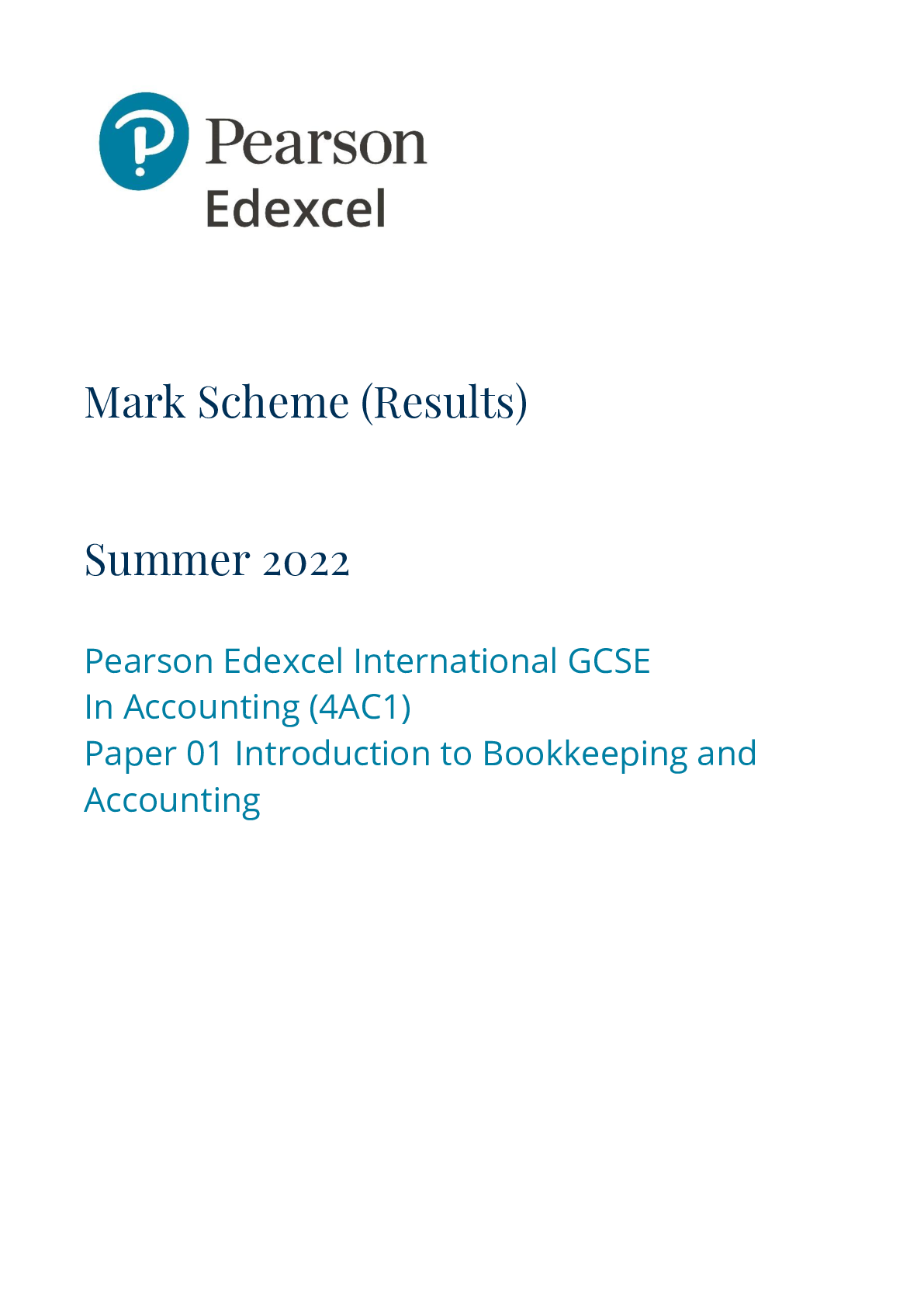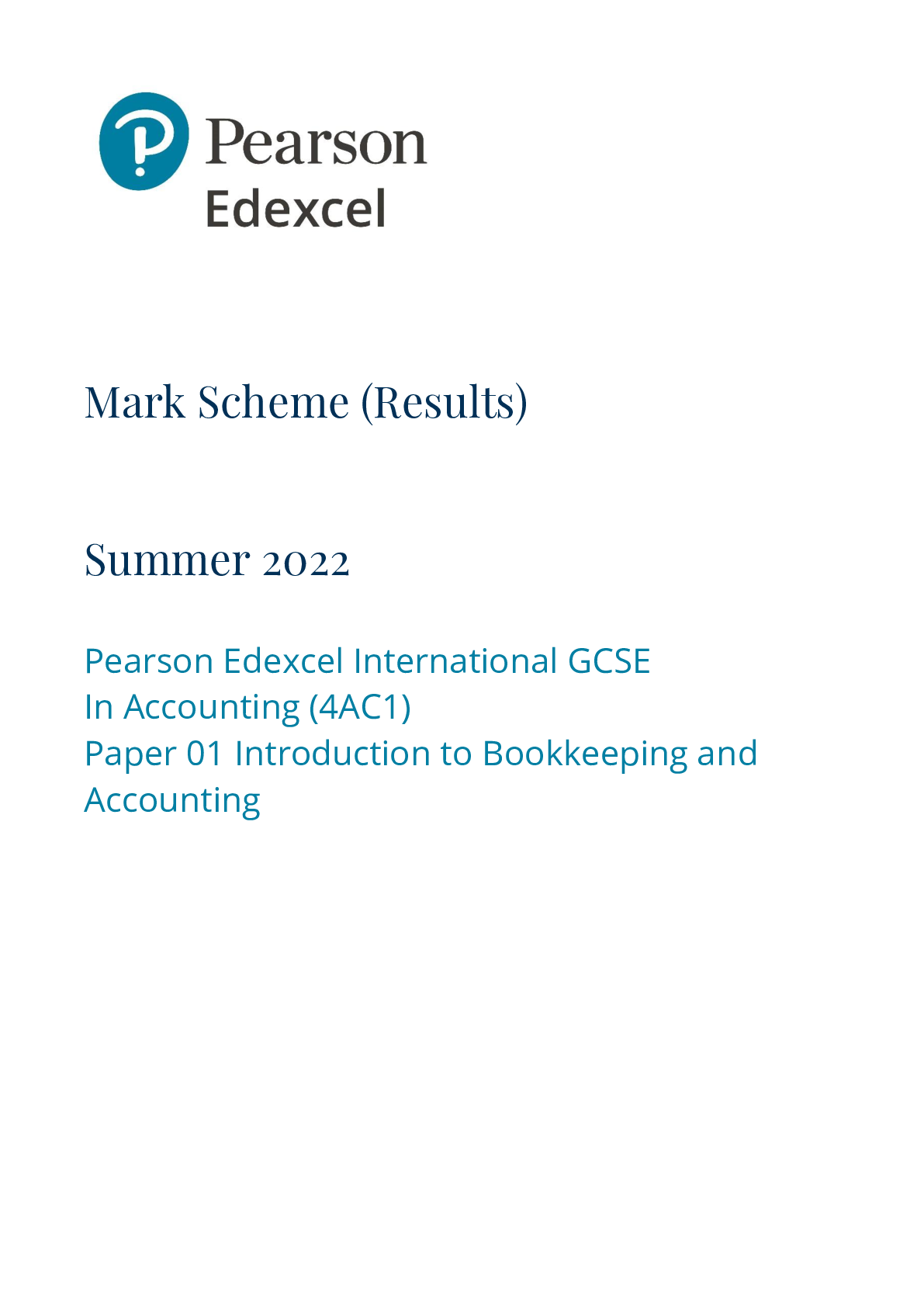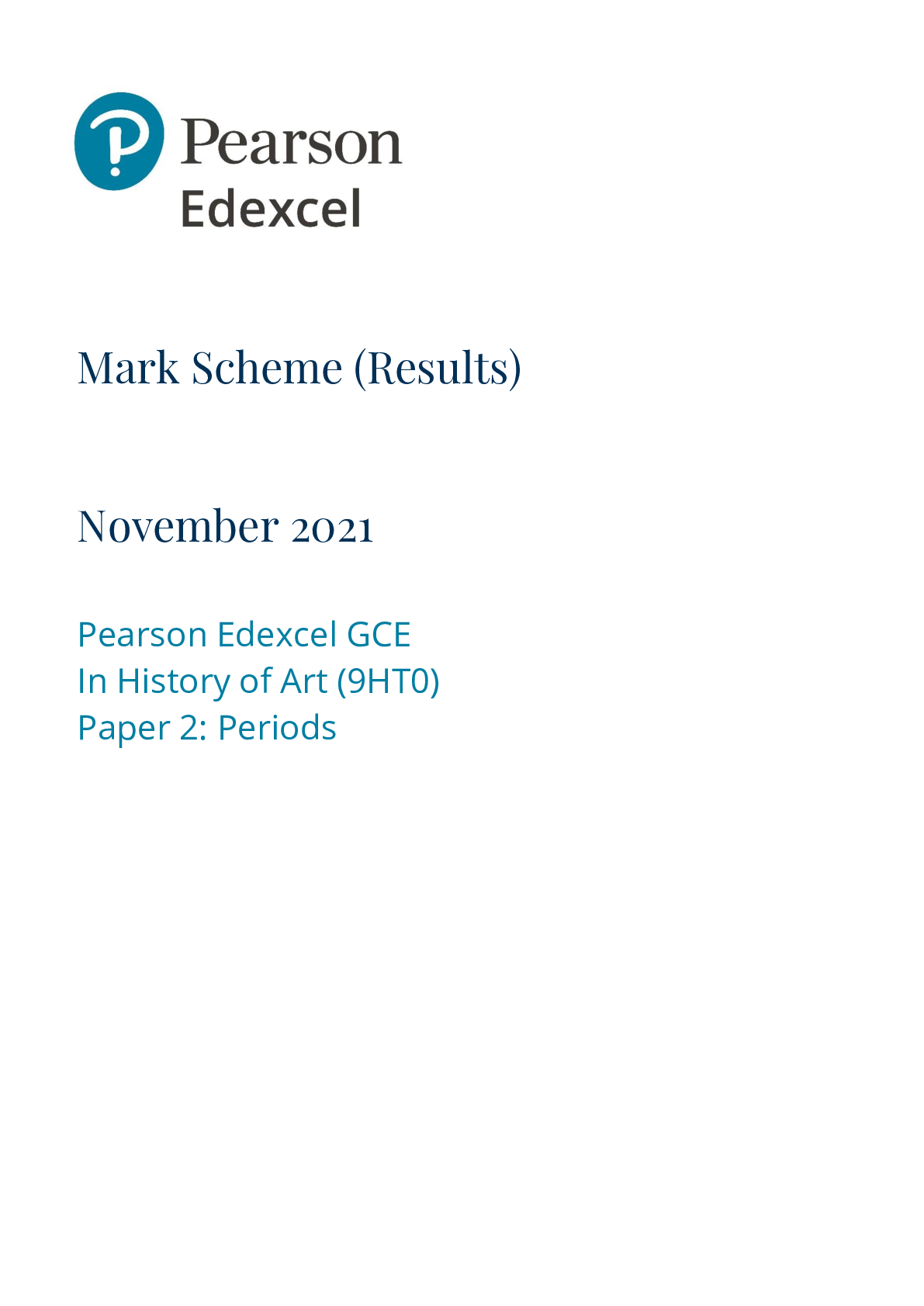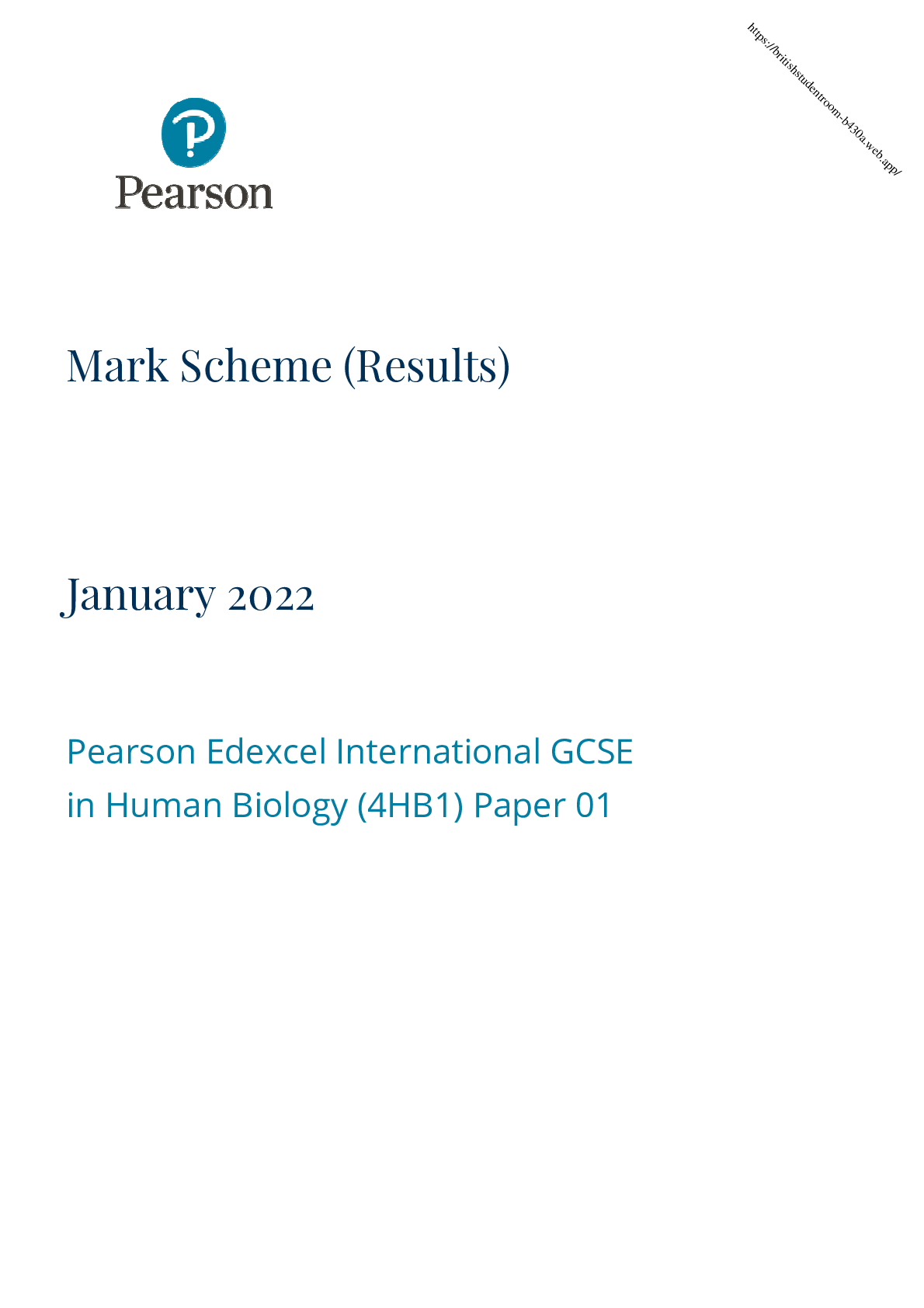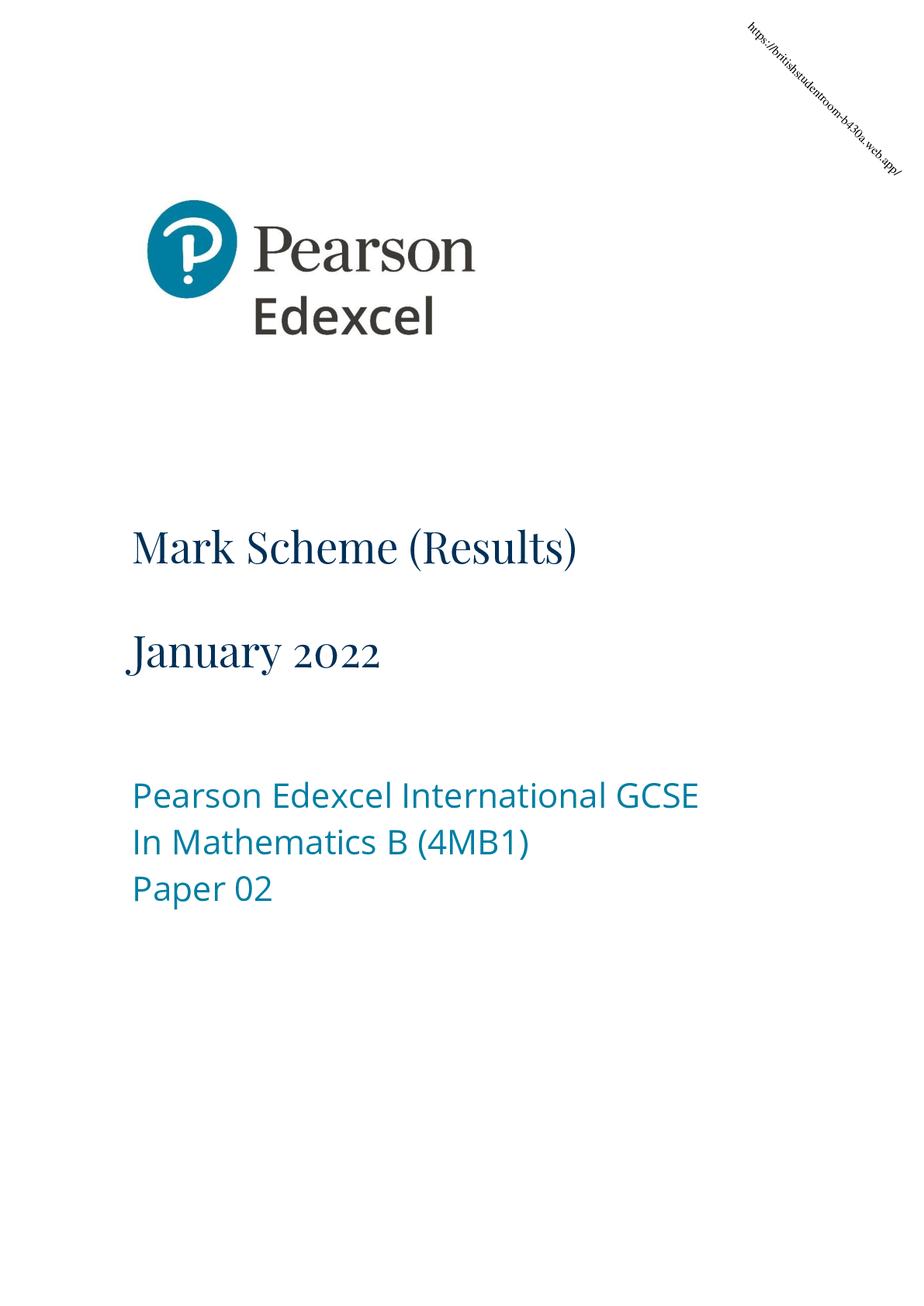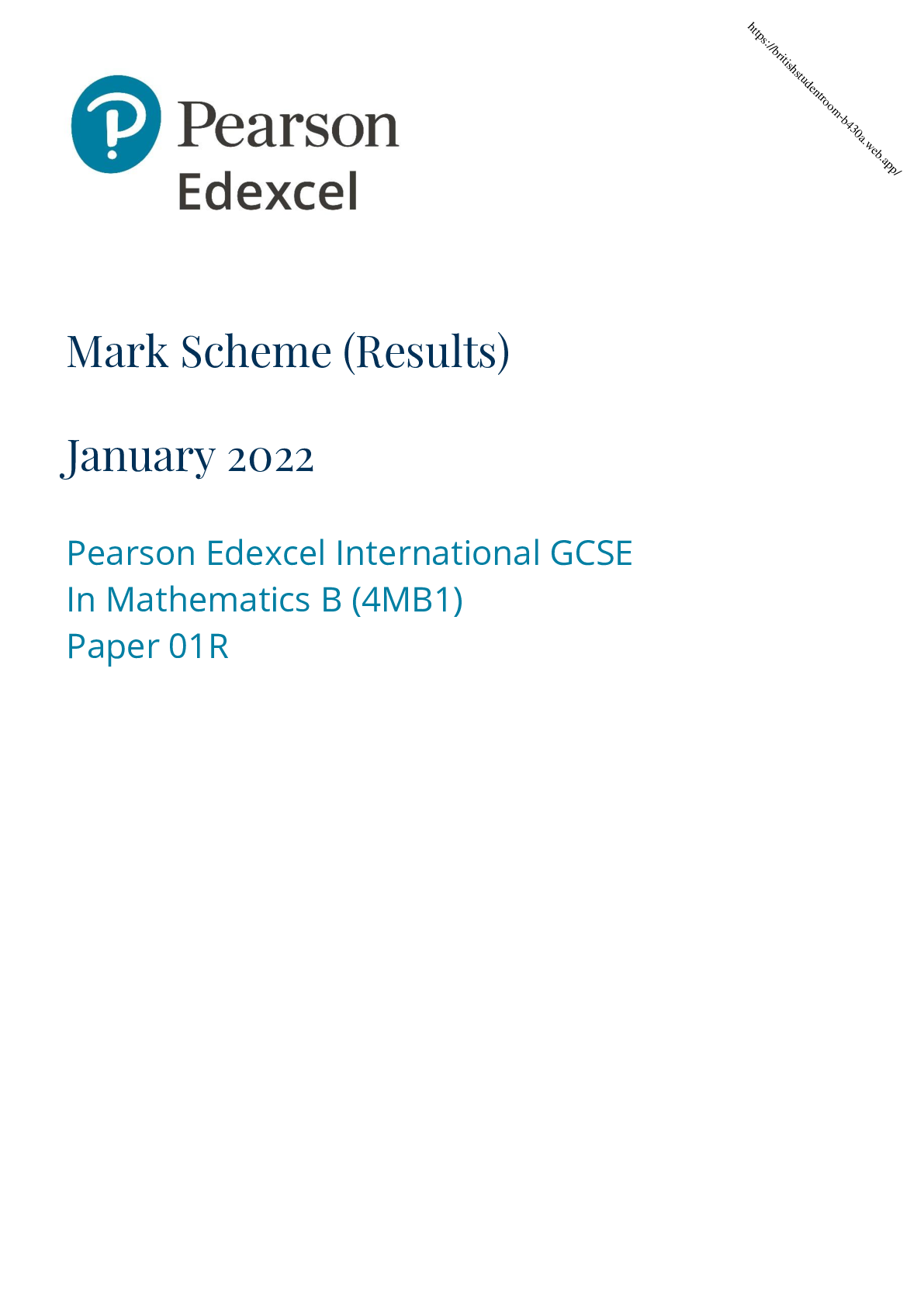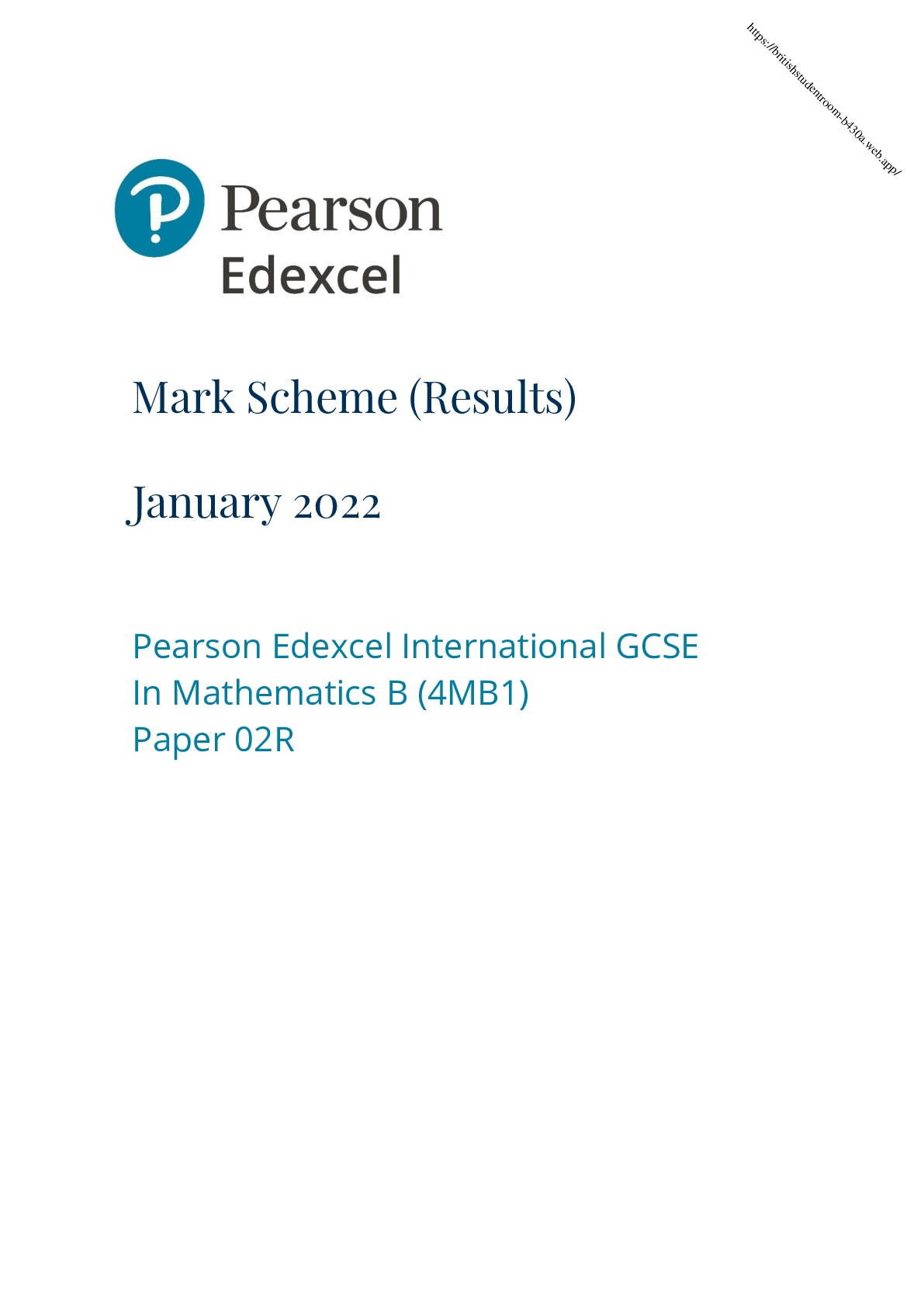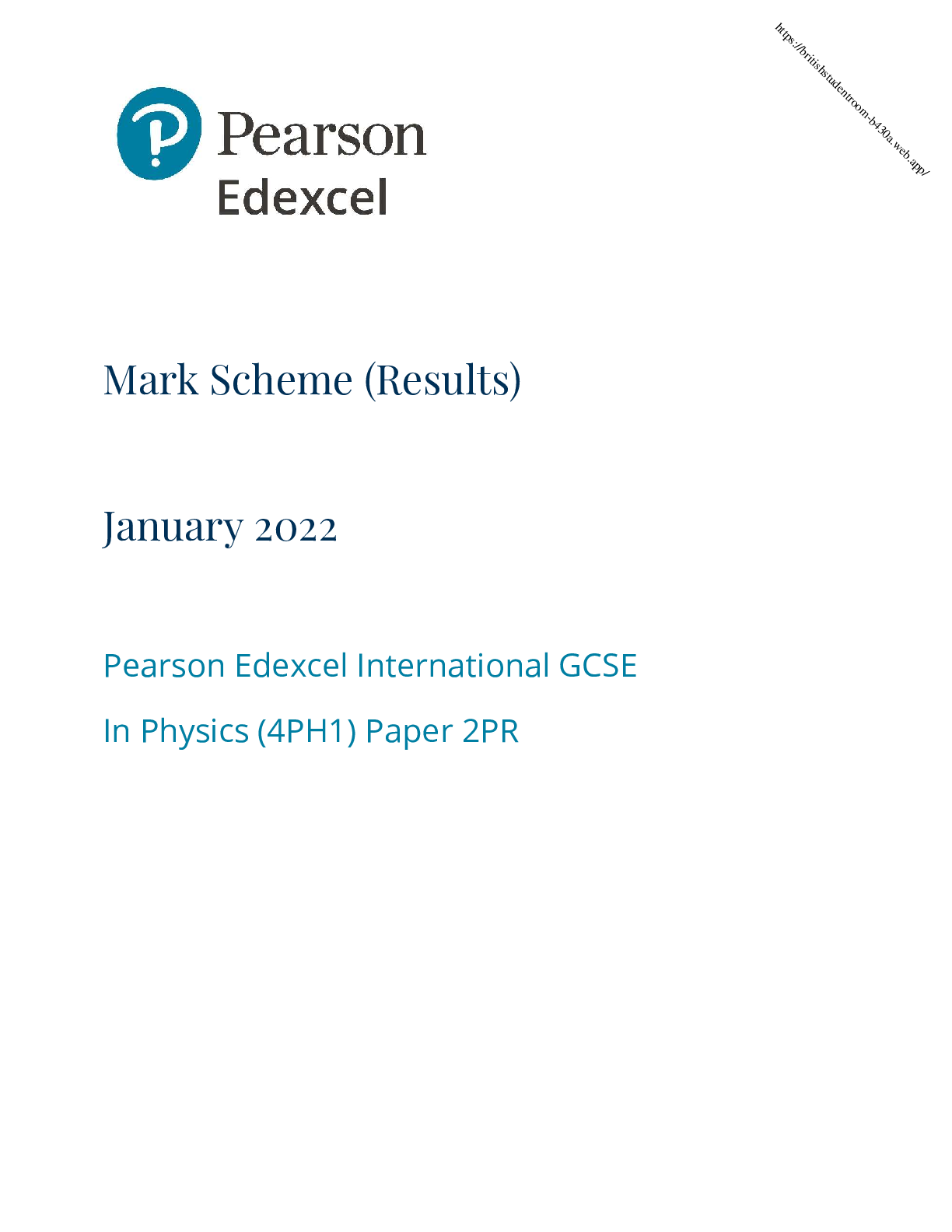Computer Science > MARK SCHEME > Mark Scheme (Results) June 2022 Pearson Edexcel GCSE In Computer Science (1CP2/02) Paper 2: Appli (All)
Mark Scheme (Results) June 2022 Pearson Edexcel GCSE In Computer Science (1CP2/02) Paper 2: Application of Computational
Document Content and Description Below
Mark Scheme (Results) June 2022 Pearson Edexcel GCSE In Computer Science (1CP2/02) Paper 2: Application of Computational Thinking Edexcel and BTEC Qualifications Edexcel and BTEC qualificat... ions are awarded by Pearson, the UK’s largest awarding body. We provide a wide range of qualifications including academic, vocational, occupational and specific programmes for employers. For further information visit our qualifications websites at www.edexcel.com or www.btec.co.uk. Alternatively, you can get in touch with us using the details on our contact us page at www.edexcel.com/contactus. Pearson: helping people progress, everywhere Pearson aspires to be the world’s leading learning company. Our aim is to help everyone progress in their lives through education. We believe in every kind of learning, for all kinds of people, wherever they are in the world. We’ve been involved in education for over 150 years, and by working across 70 countries, in 100 languages, we have built an international reputation for our commitment to high standards and raising achievement through innovation in education. Find out more about how we can help you and your students at: www.pearson.com/uk June 2022 Publications Code 1CP2_02_rms_20220825 All the material in this publication is copyright © Pearson Education Ltd 2022 General Marking Guidance • All candidates must receive the same treatment. Examiners must mark the first candidate in exactly the same way as they mark the last. • Mark schemes should be applied positively. Candidates must be rewarded for what they have shown they can do rather than penalised for omissions. • Examiners should mark according to the mark scheme not according to their perception of where the grade boundaries may lie. • There is no ceiling on achievement. All marks on the mark scheme should be used appropriately. • All the marks on the mark scheme are designed to be awarded. Examiners should always award full marks if deserved, i.e. if the answer matches the mark scheme. Examiners should also be prepared to award zero marks if the candidate’s response is not worthy of credit according to the mark scheme. • Where some judgement is required, mark schemes will provide the principles by which marks will be awarded and exemplification may be limited. • When examiners are in doubt regarding the application of the mark scheme to a candidate’s response, the team leader must be consulted. • Crossed out work should be marked UNLESS the candidate has replaced it with an alternative response. Question number MP Appx. Line Answer Additional guidance Mark 1 Award marks as shown. (10) 1.1 8 New line added to create integer and setting it to 0 (1) • num = 0 • num = int () num = 0 1.2 15 Use of input (<prompt>) to display a prompt (1) • Allow input(“”) 1.3 15 Conversion of string input to integer using int () (1) 1.4 20 Use of correct variable and relational operator for lower bound (1) • num > 4 • num >= 5 • 5 <= num • Allow num > 5 • Allow =< 1.5 20 Use of correct variable and relational operator for upper bound (1) • num < 31 • num <= 30 • 30 >= num • Allow num < 30 • Allow => 1.6 20 Use of AND to join the range checks (1) • Allow the use of OR to correctly exclude invalid inputs. Review mp1.4 and 1.5 to check relational operators matches logic. 1.7 23 Use of addition to convert to decimal code (1) • 60 + num • decimalCode + num • Allow + as part of compound operator, 1.8 23 Use of assignment to set value of decimalCode (=) (1) • Allow = as part of compound operator, independent of mp1.7 1.9 26 String concatenation used to join parts of string output (1) 1.10 29 Invalid input message displayed is fit for purpose (1) Question number MP Appx. Line Answer Additional guidance Mark 2 Award marks as shown. (10) 2.1 19 Any comment with the word “string” in it near the turtle.mode () call (1) 2.2 23 Name error – correct spelling of constant HEIGHT (1) 2.3 28 Attribute error – Requires a capital letter <turtle>.Turtle () (1) 2.4 36 Type error – Remove argument to <turtle>.pendown () (1) 2.5 42 Logic error – Move vertical grid line back to origin (1) theTurtle.setpos (0, 200) 2.6 48 Logic error – Correct length of vertical grid line (1) theTurtle.forward (400) 2.7 56 Logic error – Correct heading for starting point of square (1) theTurtle.setheading (90) 2.8 68 Control pen size with a constant (1) theTurtle.pensize (BIG) • Do not allow mark for first added line that uses the default ‘turtle’ rather than ‘theTurtle’, even if the rest of the line is correct. Allow follow through. 2.9 71 Set the pen colour to “gold” (1) theTurtle.pencolor ("gold") 2.10 78 Hide the turtle (1) theTurtle.hideturtle () Question number MP Appx. Line Answer Additional guidance Mark 3 Award marks as shown. (10) 3.1 5 Import the math library (1) • import math • from math import pi • from math import pow 3.2 18 Initialise ‘circleArea’ to a real number (1) 3.3 27 Correct translation of diameter calculation and assignment to ‘diameter’ (1) 3.4 31 Use of relational operator and two correct variables to construct a test for invalid input (1) • diameter > side • diameter >= side • Allow comparisons between areas of the circle and areas of the square (circleArea > squareArea) 3.5 35 Calculation of the area of the square (1) • side * side • side ** 2 • math.pow (side, 2) 3.6 39 Correct translation of exponentiation (**2) for circle area, even if remainder of formula is incorrect (1) • radius ** 2 • math.pow (radius, 2) 3.7 42 Subtraction used to calculate the positive difference between the area of the square and the area of the circle (1) • excessArea = squareArea - circleArea Levels-based mark scheme to a maximum of 3, from: 3.8 3.9 3.10 Functionality (3) Execute with test data given in question paper. Considerations for levels-based mark scheme: • [6.1.2] Translates without error, even if reduced functionality • [6.1.6] Functions correctly to produce the required output • [6.6.1] Use of constant (math.pi) in preference to estimated value (3.14…) Functionality (levels-based mark scheme) 0 1 2 3 Max. No rewardable material Functionality (when the code is run) • The component parts of the program are incorrect or incomplete, providing a program of limited functionality that meets some of the given requirements. • Program outputs are of limited accuracy and/or provide limited information. • Program responds predictably to some of the anticipated input. • Solution is not robust and may crash on anticipated or provided input. Functionality (when the code is run) • The component parts of the program are complete, providing a functional program that meets most of the stated requirements. • Program outputs are mostly accurate and informative. • Program responds predictably to most of the anticipated input. • Solution may not be robust within the constraints of the problem. Functionality (when the code is run) • The component parts of the program are complete, providing a functional program that fully meets the given requirements. • Program outputs are accurate, informative, and suitable for the user. • Program responds predictably to anticipated input. • Solution is robust within the constraints of the problem. 3 Question number MP Appx. Line Answer Additional guidance Mark 4 Award marks as shown. • Award sequence only. • Ignore intervening lines. • Ignore changes made to provided lines. • Do not award same sequence in supplied file, if no lines are moved in that subsection (15) Subprogram • If no lines are moved, not changing the sequence, then award no marks in this subsection 4.1 4.2 13 Initialisation of variables before calculations inside the subprogram, all together (One mark for any two, up to a maximum of 2) multiplier, total, digit, value (2) 4.3 18 Iteration (for loop) placed at highest level inside subprogram, after initialisation of local variables (1) Order of calculations maintained: • Order of lines must be digit, followed by value, followed by total. • Multiplier must be after value. 4.4 19 digit must be the first of the sequence (1) 4.5 20 value (1) 4.6 21 total (1) 4.7 22 multiplier (1) 4.8 24 Return statement is last line in subprogram (1) Main Program • If no lines are moved, not changing the sequence, then award no marks in this subsection 4.9 31 User input accepted as first operation in main program (1) 4.10 32 Repetition (while loop) after any input (1) 4.11 33 Call to ‘binaryLoop’ subprogram inside repetition (while loop) (1) 4.12 34 Output of result follows call to subprogram (1) 4.13 35 User input accepted as last operation in main program, inside loop (1) Additional 4.14 Functions for any sequence of 1s and 0s and exits on empty string (1) • Execute with test data given in question paper 4.15 Adherence to accurate indentation (1) Question number MP Appx. Line Answer Additional guidance Mark 5 Award marks as shown. (15) Preparation 5.1 File opened for writing only (1) 5.2 Constant used as file name to open (1) Processing all items in array 5.3 A loop to process every item in the given data structure (1) • for or while Controlling width of data output to file 5.4 Mechanism for controlling seven items (1) • if or for 5.5 Constant used to compare against count for column control (1) Formatting of output line 5.6 Line feed added to each line of output [Show More]
Last updated: 1 year ago
Preview 1 out of 29 pages
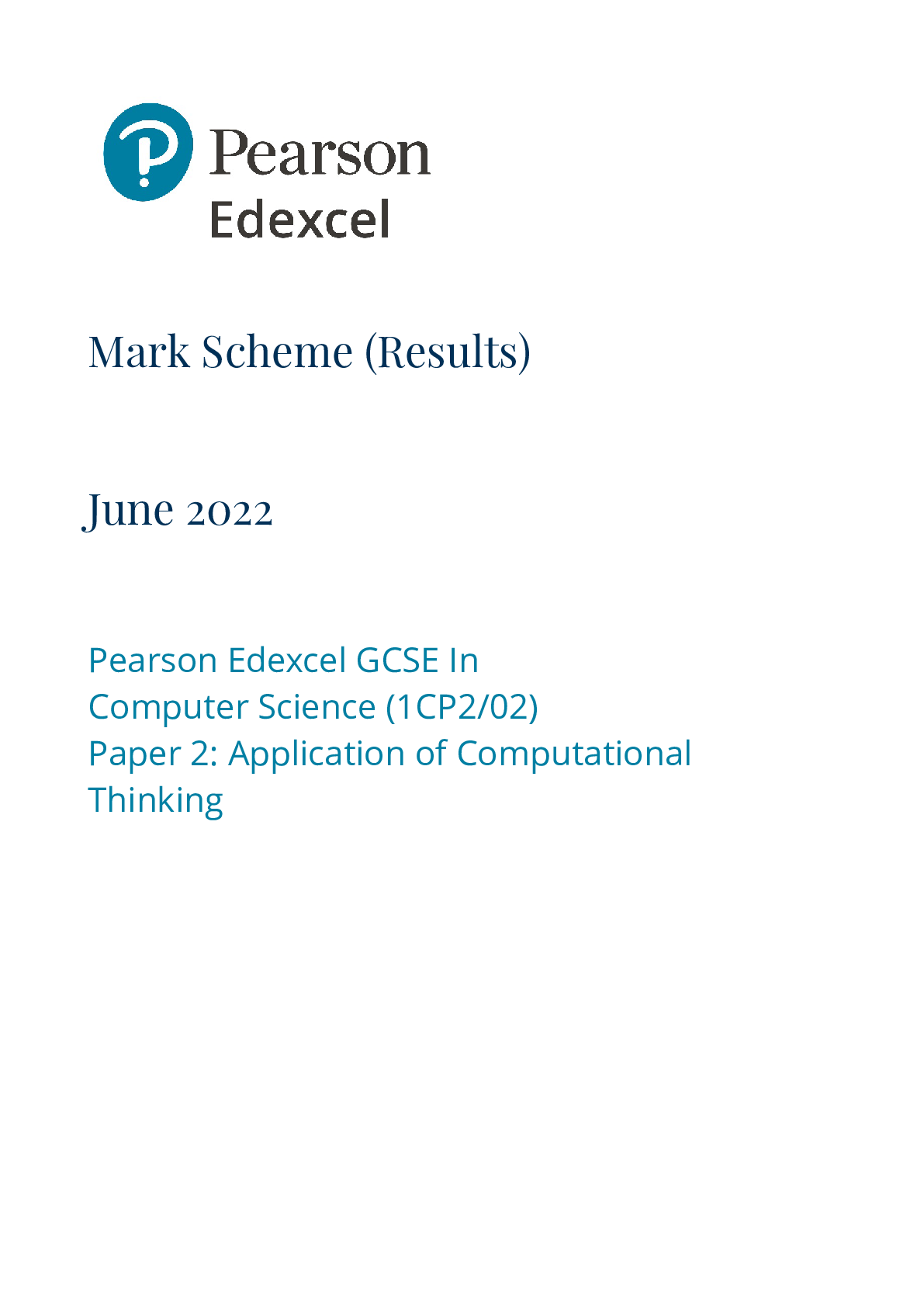
Reviews( 0 )
Document information
Connected school, study & course
About the document
Uploaded On
Apr 03, 2023
Number of pages
29
Written in
Additional information
This document has been written for:
Uploaded
Apr 03, 2023
Downloads
0
Views
94

